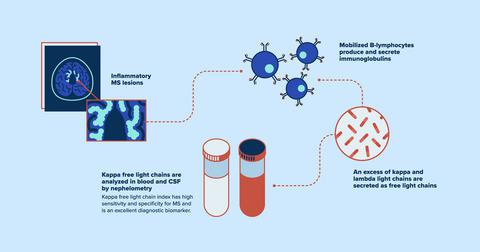当前位置:
X-MOL 学术
›
J. Neurochem.
›
论文详情
Our official English website, www.x-mol.net, welcomes your
feedback! (Note: you will need to create a separate account there.)
Kappa free light chain index as a diagnostic biomarker in multiple sclerosis: A real-world investigation
Journal of Neurochemistry ( IF 4.2 ) Pub Date : 2021-09-03 , DOI: 10.1111/jnc.15500 Igal Rosenstein 1 , Sofia Rasch 2 , Markus Axelsson 1 , Lenka Novakova 1 , Kaj Blennow 2, 3 , Henrik Zetterberg 2, 3, 4, 5, 6 , Jan Lycke 1
Journal of Neurochemistry ( IF 4.2 ) Pub Date : 2021-09-03 , DOI: 10.1111/jnc.15500 Igal Rosenstein 1 , Sofia Rasch 2 , Markus Axelsson 1 , Lenka Novakova 1 , Kaj Blennow 2, 3 , Henrik Zetterberg 2, 3, 4, 5, 6 , Jan Lycke 1
Affiliation

|
Kappa free light chain (KFLC) index, a measure for intrathecal production of free kappa chains, has been increasingly recognized for its diagnostic potential in multiple sclerosis (MS) as a quantitative alternative to IgG oligoclonal bands (OCBs). Our objective was to investigate the sensitivity, specificity, and overall diagnostic accuracy of KFLC index in MS. KFLC index was prospectively determined as part of the diagnostic workup in patients with suspected MS (n = 327) between May 2013 and February 2020. Patients with clinically isolated syndrome (CIS), radiologically isolated syndrome (RIS), and MS had markedly higher KFLC index (44.6, IQR 16–128) compared with subjects with other neuro-inflammatory disorders (ONID) and symptomatic controls (SC) (2.19, IQR 1.68–2.98, p < 0.001). KFLC index had a sensitivity of 0.93 (95% CI 0.88–0.95) and specificity of 0.87 (95% CI 0.8–0.92) to discriminate CIS/RIS/MS from ONID and SC (AUC 0.94, 95% CI 0.91–0.97, p < 0.001). KFLC index and intrathecal fraction (IF) KFLC had similar accuracies to detect MS. Treatment with disease-modifying therapy (DMT) did not influence the level of KFLC index and it was not affected by demographic factors or associated with degenerative or inflammatory biomarkers in cerebrospinal fluid (CSF). KFLC index in MS diagnostics has methodological advantages compared to OCB and is independent to subjective interpretation. Moreover, it is an attractive diagnostic tool since the diagnostic specificity and sensitivity of KFLC index are similar with that of OCBs and KFLCIF and better than for IgG index. We show that KFLC index was influenced neither by DMT nor by demographic factors or other inflammatory or degenerative processes in MS as determined by biomarkers in CSF.
中文翻译:

Kappa 游离轻链指数作为多发性硬化症的诊断生物标志物:一项真实世界的调查
Kappa 游离轻链 (KFLC) 指数是一种鞘内产生游离 kappa 链的指标,因其作为 IgG 寡克隆带 (OCB) 的定量替代品在多发性硬化症 (MS) 中的诊断潜力而得到越来越多的认可。我们的目标是研究 KFLC 指数在 MS 中的敏感性、特异性和整体诊断准确性。KFLC 指数作为 2013 年 5 月至 2020 年 2 月期间疑似 MS 患者(n = 327)的诊断检查的一部分被前瞻性确定。临床孤立综合征 (CIS)、放射学孤立综合征 (RIS) 和 MS 患者的 KFLC 显着升高指数 (44.6, IQR 16-128) 与其他神经炎症性疾病 (ONID) 和症状对照 (SC) 的受试者相比 (2.19, IQR 1.68-2.98, p < 0.001)。KFLC 指数区分 CIS/RIS/MS 与 ONID 和 SC(AUC 0.94,95% CI 0.91-0.97,p < 0.001)。KFLC 指数和鞘内分数 (IF) KFLC 在检测 MS 方面具有相似的准确度。疾病改善疗法 (DMT) 治疗不影响 KFLC 指数的水平,也不受人口统计因素的影响,也不受脑脊液 (CSF) 中退行性或炎症生物标志物的影响。与 OCB 相比,MS 诊断中的 KFLC 指数具有方法学优势,并且独立于主观解释。此外,它是一种有吸引力的诊断工具,因为 KFLC 指数的诊断特异性和敏感性与 OCB 和 KFLC IF相似并且优于 IgG 指数。我们表明 KFLC 指数既不受 DMT 的影响,也不受人口统计因素或 MS 中其他炎症或退行性过程的影响,如由脑脊液中的生物标志物确定的。
更新日期:2021-10-27
中文翻译:

Kappa 游离轻链指数作为多发性硬化症的诊断生物标志物:一项真实世界的调查
Kappa 游离轻链 (KFLC) 指数是一种鞘内产生游离 kappa 链的指标,因其作为 IgG 寡克隆带 (OCB) 的定量替代品在多发性硬化症 (MS) 中的诊断潜力而得到越来越多的认可。我们的目标是研究 KFLC 指数在 MS 中的敏感性、特异性和整体诊断准确性。KFLC 指数作为 2013 年 5 月至 2020 年 2 月期间疑似 MS 患者(n = 327)的诊断检查的一部分被前瞻性确定。临床孤立综合征 (CIS)、放射学孤立综合征 (RIS) 和 MS 患者的 KFLC 显着升高指数 (44.6, IQR 16-128) 与其他神经炎症性疾病 (ONID) 和症状对照 (SC) 的受试者相比 (2.19, IQR 1.68-2.98, p < 0.001)。KFLC 指数区分 CIS/RIS/MS 与 ONID 和 SC(AUC 0.94,95% CI 0.91-0.97,p < 0.001)。KFLC 指数和鞘内分数 (IF) KFLC 在检测 MS 方面具有相似的准确度。疾病改善疗法 (DMT) 治疗不影响 KFLC 指数的水平,也不受人口统计因素的影响,也不受脑脊液 (CSF) 中退行性或炎症生物标志物的影响。与 OCB 相比,MS 诊断中的 KFLC 指数具有方法学优势,并且独立于主观解释。此外,它是一种有吸引力的诊断工具,因为 KFLC 指数的诊断特异性和敏感性与 OCB 和 KFLC IF相似并且优于 IgG 指数。我们表明 KFLC 指数既不受 DMT 的影响,也不受人口统计因素或 MS 中其他炎症或退行性过程的影响,如由脑脊液中的生物标志物确定的。











































 京公网安备 11010802027423号
京公网安备 11010802027423号